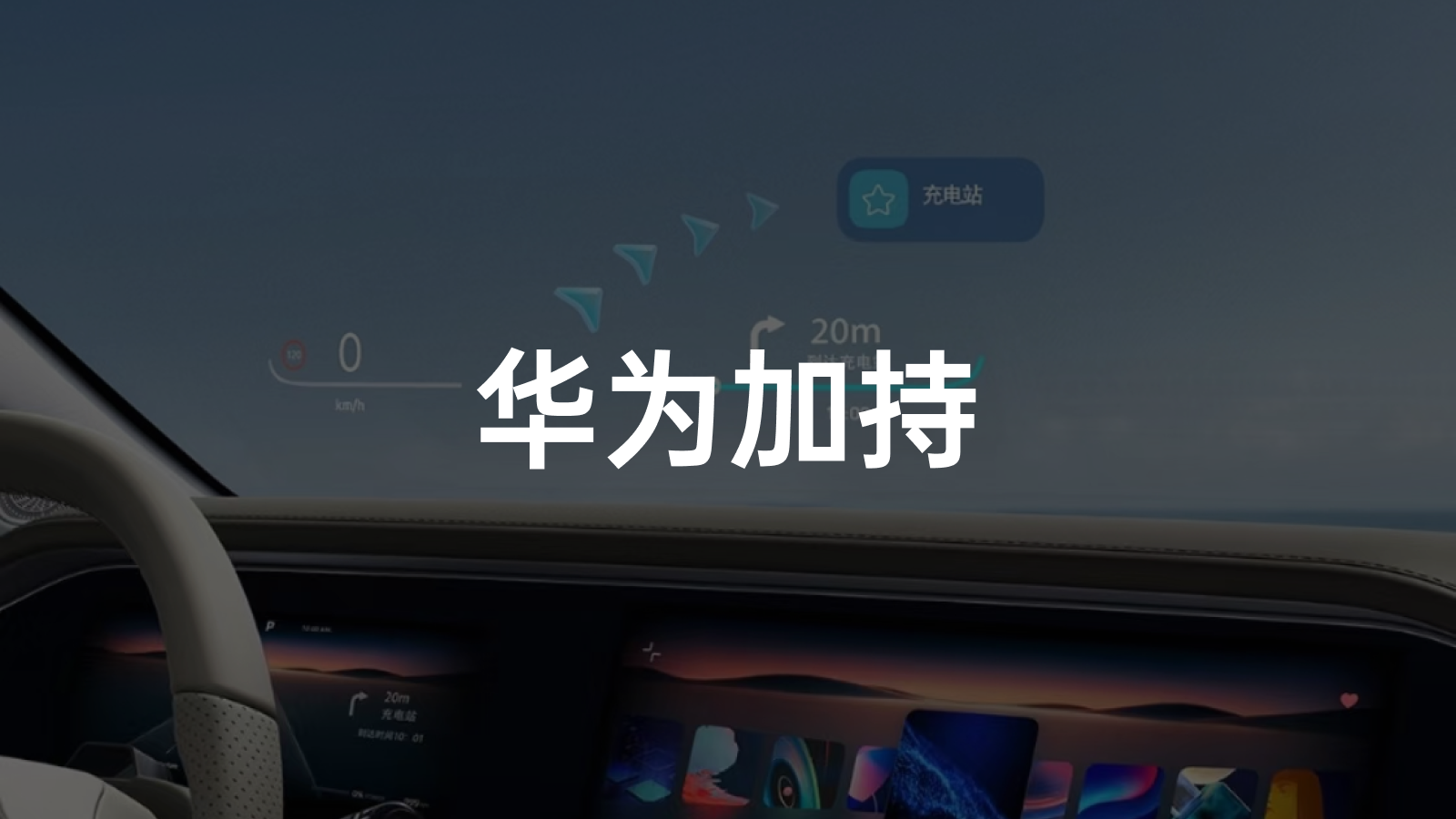On May 7th, RisingAuto released information about the cabin of the R7, including the mention of the Huawei Vision Enhancement AR-HUD system. Although the static images display a lot of information, people are very curious about what the specific effects can be achieved. Today, the RisingAuto Automotive Official has released more detailed information about this AR-HUD.
Although I am not picky about intelligent configurations, the HUD function has never appeared in the list of essential car functions I have listed.
In my opinion, HUD is a secondary function that can be added to the top without being necessary, so before we analyze what the AR-HUD system of RisingAuto R7 can do, let’s take a look at the advantages and disadvantages of HUD.
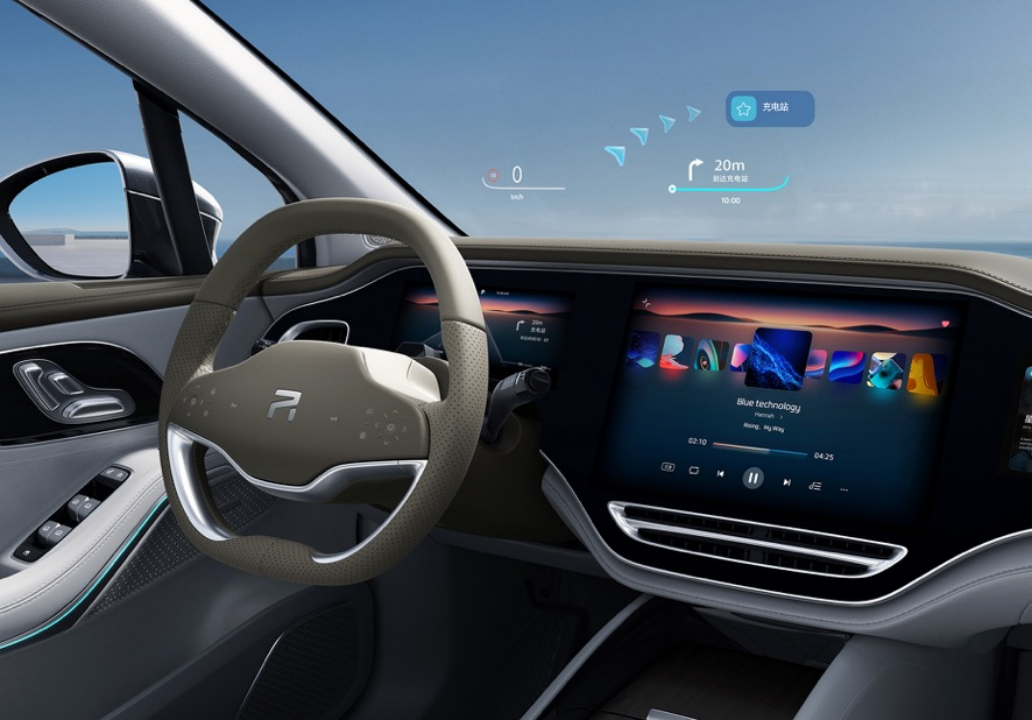
Pros and Cons of HUD
HUD stands for Head-Up Display. In fact, the predecessor of HUD is the optical sight used on fighter aircraft. This kind of sight uses optical reflection principle to project the circular aiming circle light net onto a piece of glass or cockpit cover in front of the cockpit. When the pilot aims at the target, he can also observe the surroundings to avoid accidents caused by lack of concentration.
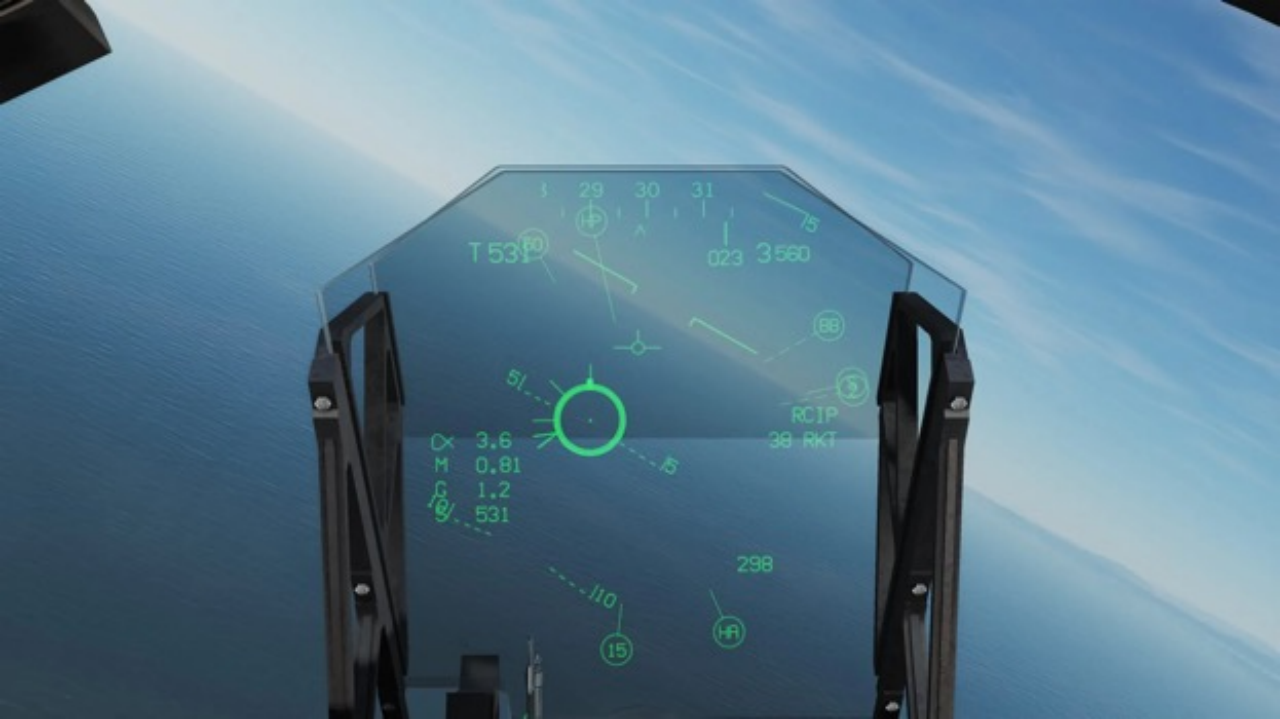
After the military technology is civilianized, HUD with such advantages is naturally used in car driving that also requires concentration.
Through the HUD display installed in the car, the driver can check the status information of the car at any time during driving, such as speed, time, etc., while the eyes do not need to leave the road, greatly improving the safety of driving.
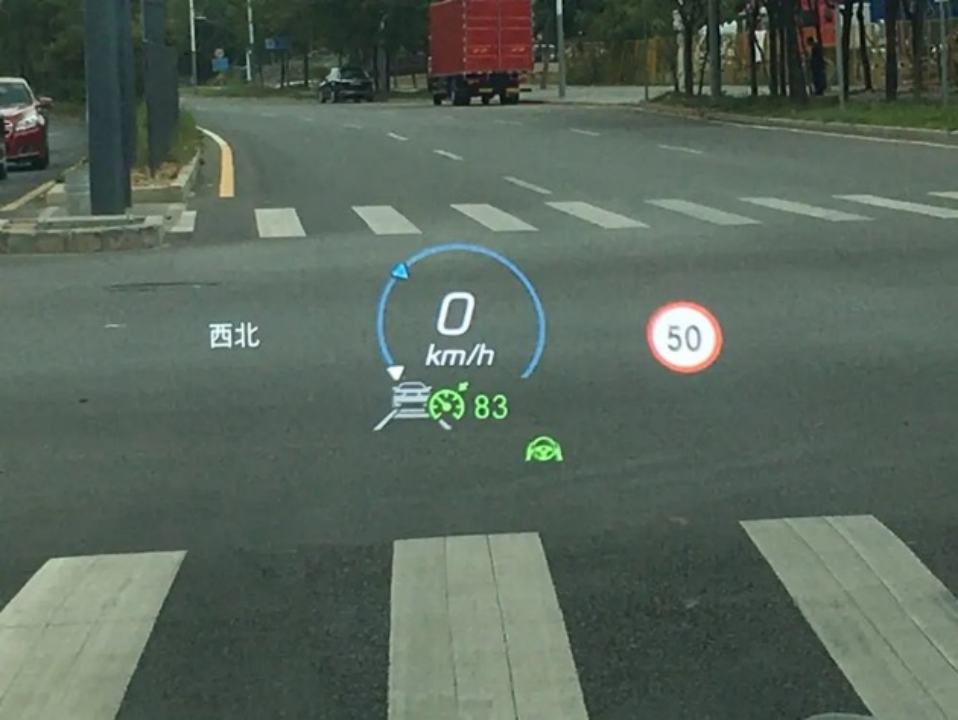
However, from the first appearance of HUD as an optional configuration on mass-produced cars in 1990 until the past two years, **the application scenario of HUD has not been expanded much, and its function has been limited to displaying basic information such as vehicle speed. Even if it is enriched, it is only displaying simple navigation indications and the name of the currently playing music album. It seems that **this high-precision technology originating from military use has been stagnating in the application and development in the automotive field.Actually, I have driven some car models equipped with HUD functionality before. Firstly, it must be affirmed that in the ideal usage environment, the HUD display position is exactly in the driver’s line of sight when looking straight ahead, without any need for large-angle eye movement. Even if the eyes are focused on the content displayed on the HUD, it is still possible to respond promptly to sudden changes on the road surface, which saved me from some “speed bumps” on the city streets several times.
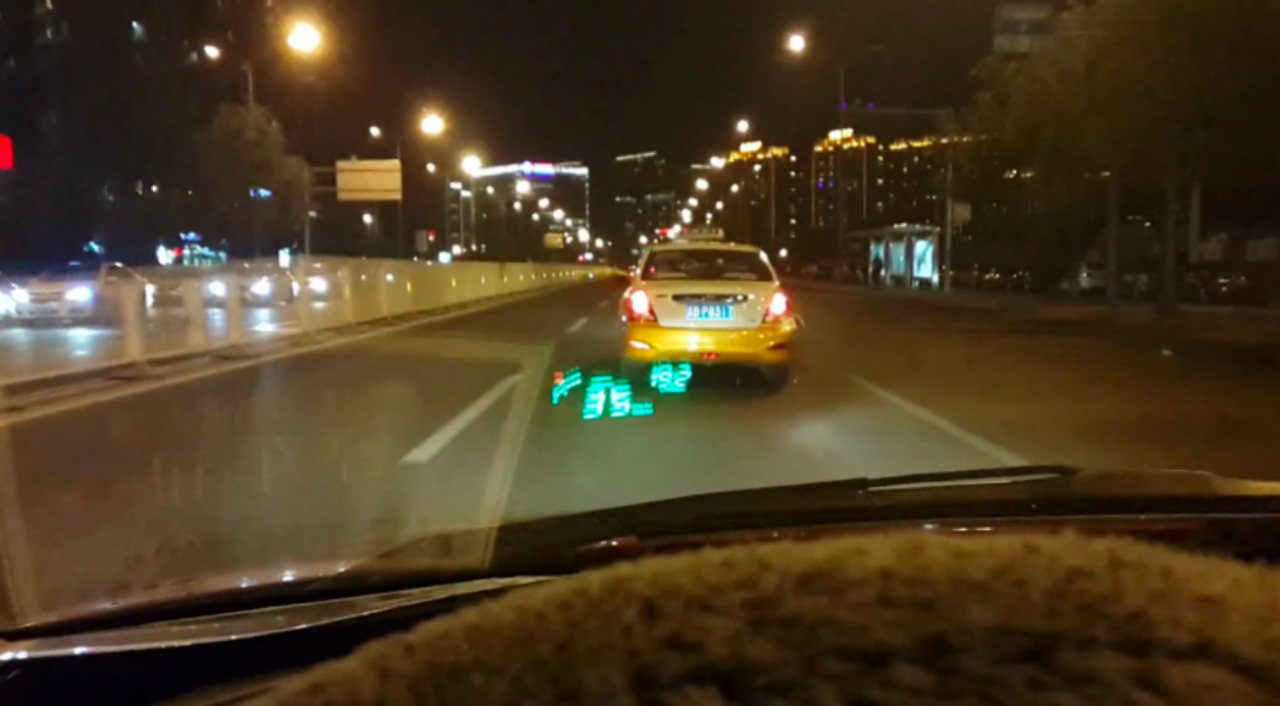
However, it must also be pointed out that aside from the issue with too little display information mentioned earlier, the brightness of some car models’ HUDs is insufficient and the display is not clear enough when the sunlight is strong, which could seriously blur the HUD display due to left and right eye distortion differences and even impact the line of sight, making it difficult to drive safely. Therefore, doing HUD properly really requires a lot of effort and cost. In addition, considering the high cost of HUD and the fact that it may not necessarily bring any effect, most car models’ HUD functions are still only available as optional extras in the configuration list at present.
Throughout the entire intelligent electric vehicle industry, the number of vehicles equipped with HUD is increasing. Due to the continuous improvement in the degree of vehicle intelligence, more and more driving information, intelligent driving, and ADAS information are displayed inside the vehicle. For the sake of driving safety, the trend of installing HUD is still significant.
For drivers, the priority of road information is certainly the highest. Therefore, the “head-up” area in HUD display is currently the optimal position for human-machine interaction, much better than the areas where instruments and central control screens are located. Unfortunately, the HUD of many car models is a typical example of “holding onto the toilet without using it,” displaying poor content in the best location. It can be said that the experience still needs to be optimized.
What has Huawei brought to HUD?
In fact, I was not surprised that the Feovan R7 has a HUD function, because after all, it is a flagship product that emphasizes technology and intelligence. If it did not have HUD functionality, it would be unacceptable. However, this HUD system on the Feovan R7 seems to be a bit different. Firstly, its name is AR-HUD visual enhancement parallel viewing system. What is AR-HUD?
In simple terms, AR-HUD is a HUD system that adds AR functionality to the basis of HUD, with a larger imaging area, longer projection distance, and higher clarity. Most importantly, the information displayed can be integrated into the environment. It is equipped on the latest flagship car models, such as the Mercedes-Benz S-Class.
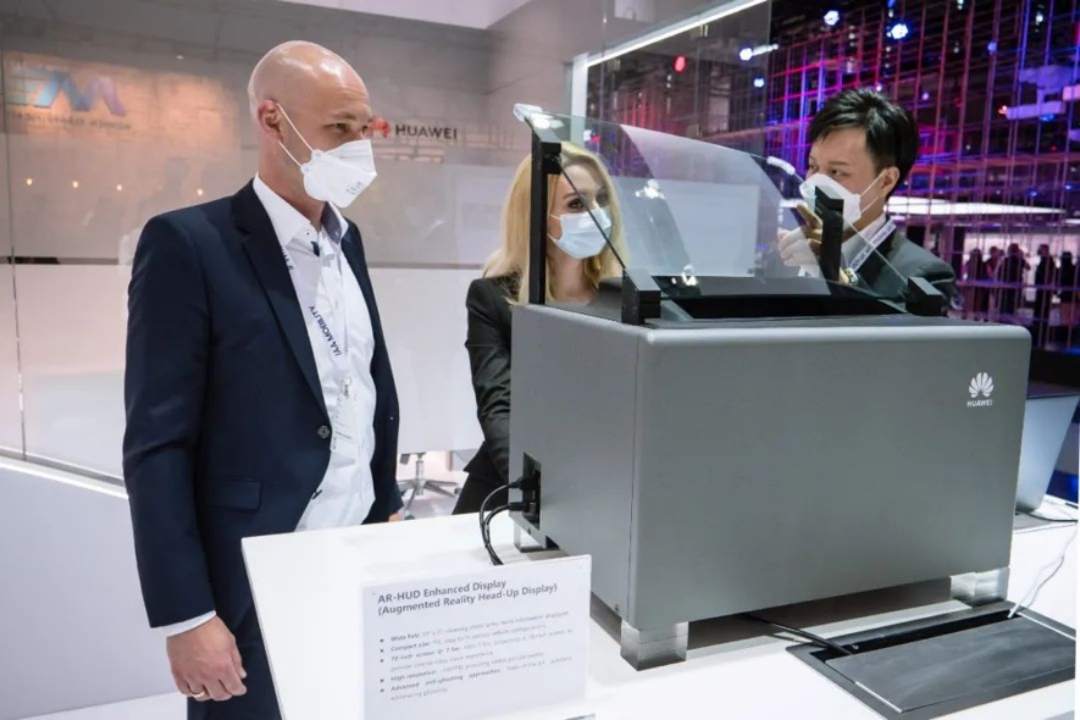 # Translate to English Markdown
# Translate to English Markdown
The AR-HUD system used in this Fevan R7 is from Huawei, and it is also the global debut of Huawei’s latest AR-HUD system. This naturally aroused my interest, after all, Huawei is considered a gold signboard in the current technology industry. I am really looking forward to what Huawei’s AR-HUD can bring us, and whether it has the opportunity to improve the shortcomings of the current HUD function.
Improvement based on hardware
An excellent user experience cannot be achieved without powerful hardware support. Before experiencing the effect of this set of AR-HUD, let’s take a look at the performance of the AR-HUD system on basic hardware parameters.
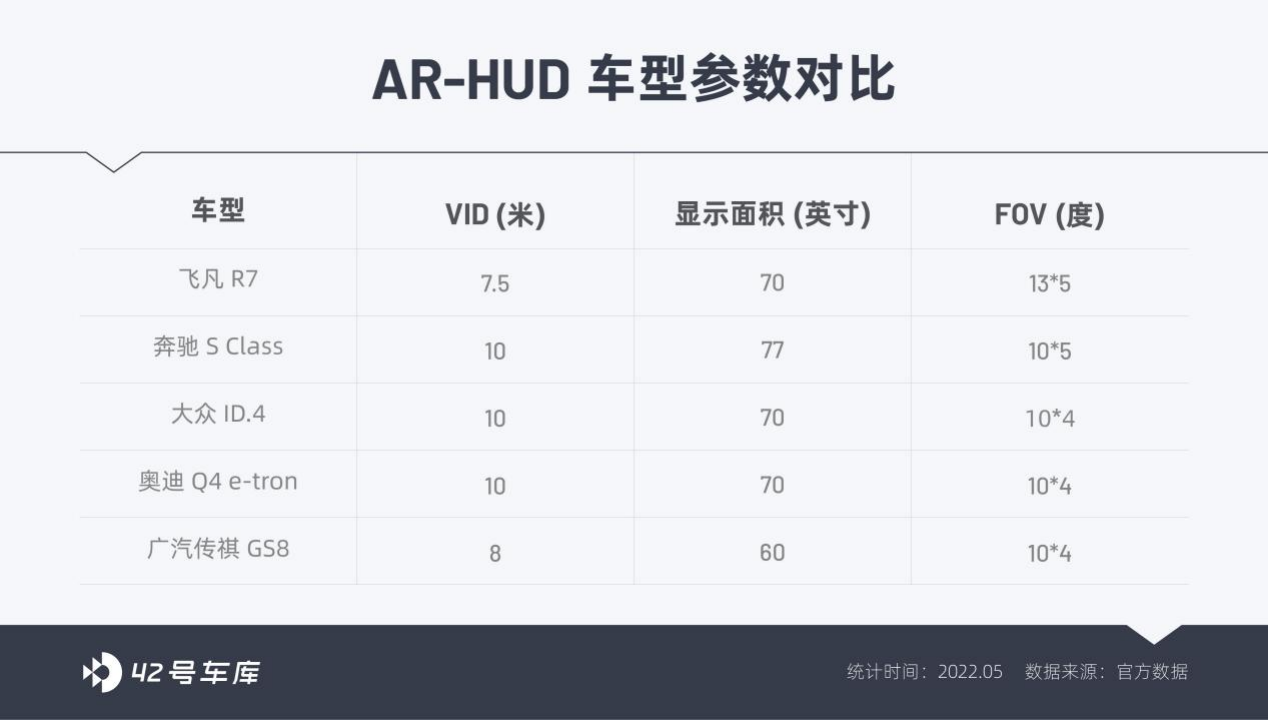
As you can see, the Huawei AR-HUD installed in Fevan R7 has taken the title of the largest FOV (Field of View) of mass-produced models in the world for the first time. In simple terms, the larger the FOV, the wider the display range, and the richer the content. In general, the FOV of AR-HUD should be at least 10° x 5° to ensure a sufficient display area to show AR content.
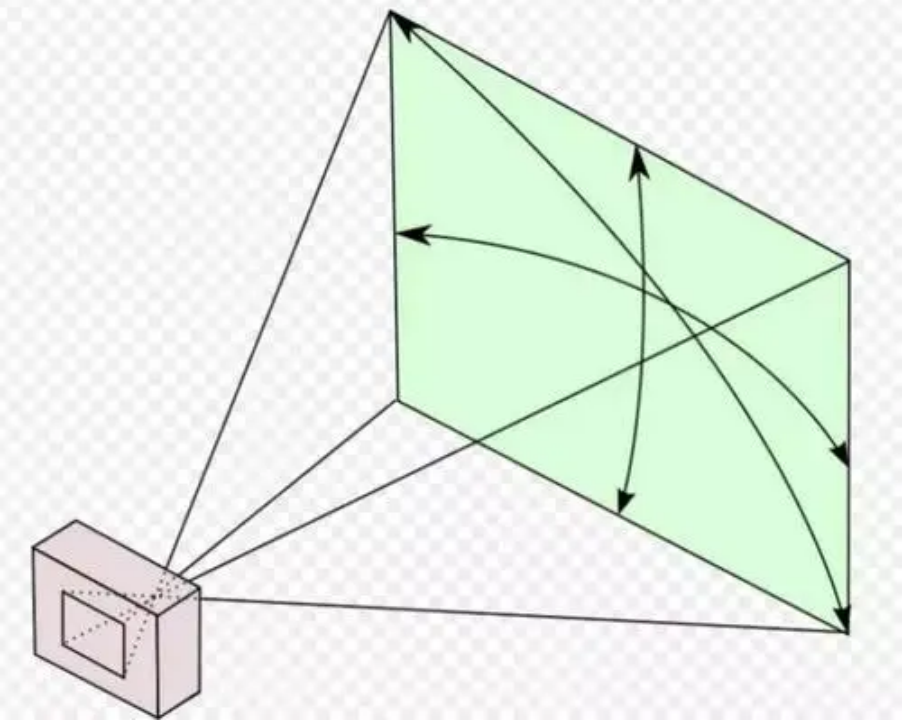
Fevan R7 has surpassed Mercedes-Benz S in this regard, although it is slightly inferior in terms of display area, it can still be regarded as full of sincerity in the price range of 300,000 to 400,000 yuan.
At the same time, under the premise of sufficient display area, Fevan R7 also provides a HUD with the highest resolution of any mass-produced model in the world, which can reach 1,920 × 730, with a contrast ratio of 1,200:1. Higher resolution can bring a more delicate visual experience, reducing the edge fringing of HUD displayed text.
It also performs in the top tier in terms of brightness, with a maximum brightness of 12,000 nits, which can provide stable, clear and bright images even in strong sunlight. At the same time, this set of Huawei AR-HUD has the ability to automatically detect ambient brightness and adjust the brightness of HUD lighting to adapt to the environment, reducing the driver’s short-term discomfort caused by changes in lighting conditions.
What surprises me most is that this set of AR-HUD in Fevan R7 also thoughtfully includes a snow mode, which can switch the display color to green when it is turned on to avoid the problem of unclear vision caused by white color when driving in the snow.
ODP Optical Engine
And the black technology behind all these outstanding parameters is this Huawei ODP optical engine. To find out where its strength lies, you must first understand the working principle of HUD.In simple terms, HUD utilizes the principle of optical reflection to emit an image from a light source, which is then projected onto the windshield as a virtual image through double reflection from a reflective mirror and a projection mirror. There are three main imaging technologies in mainstream use: TFT-LCD, DLP, and LCoS.

Among them, TFT-LCD is the most widely used, which utilizes a backlight source to illuminate the LCD and then changes the polarization state of the light source driven by the TFT to present different brightness levels. The RGB color filter is used to present a color image.
DLP stands for Digital Light Processing technology, which utilizes the digital micromirror device (DMD) as its core component. The DMD is a rectangular array of micromirrors, usually comprising up to 1.3 million articulated mirrors, with one mirror corresponding to one pixel. The signal projection switch is achieved through the tilting of the micromirrors, which realizes the connection and disconnection of the light for each pixel.
Compared with TFT-LCD, DLP has the characteristics of high resolution, high brightness, and better imaging effects. However, it is necessary to avoid blurred display by matching high-precision reflective non-spherical glass for the specific vehicle due to the full planar projection of DLP.
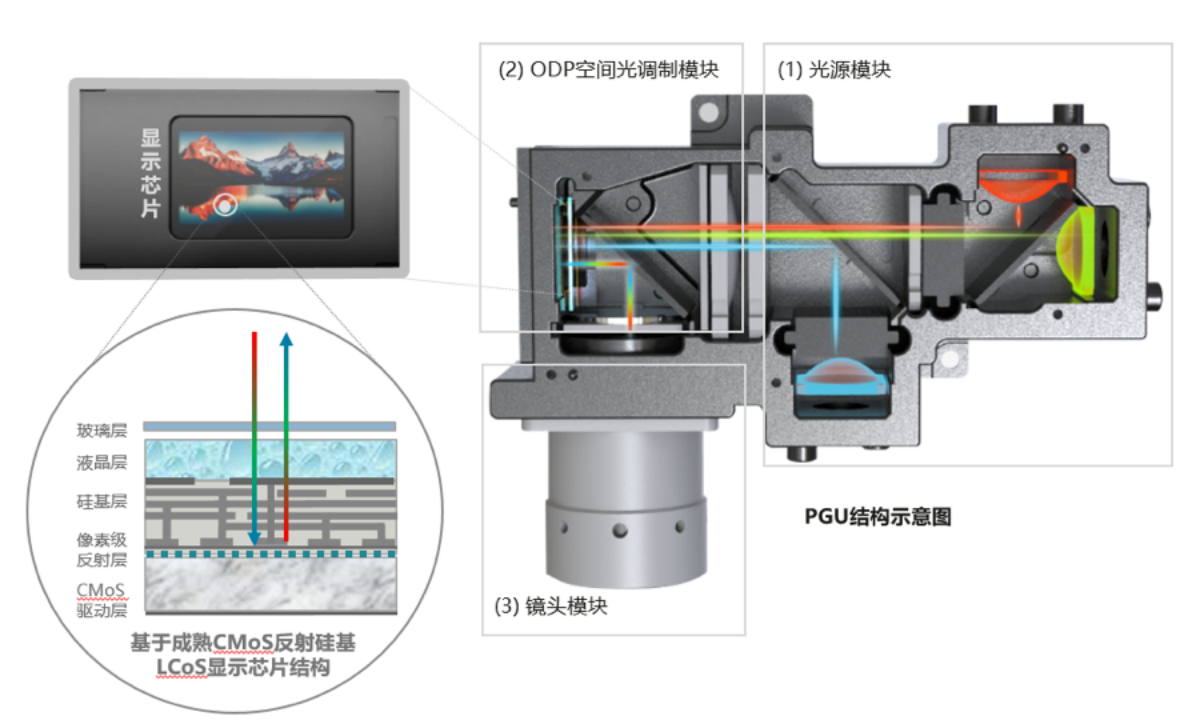
LCoS, or Liquid Crystal on Silicon technology, is an upgraded version of LCD that replaces the glass substrate used by LCD with a silicon wafer, which is also known as a chip silicon base.
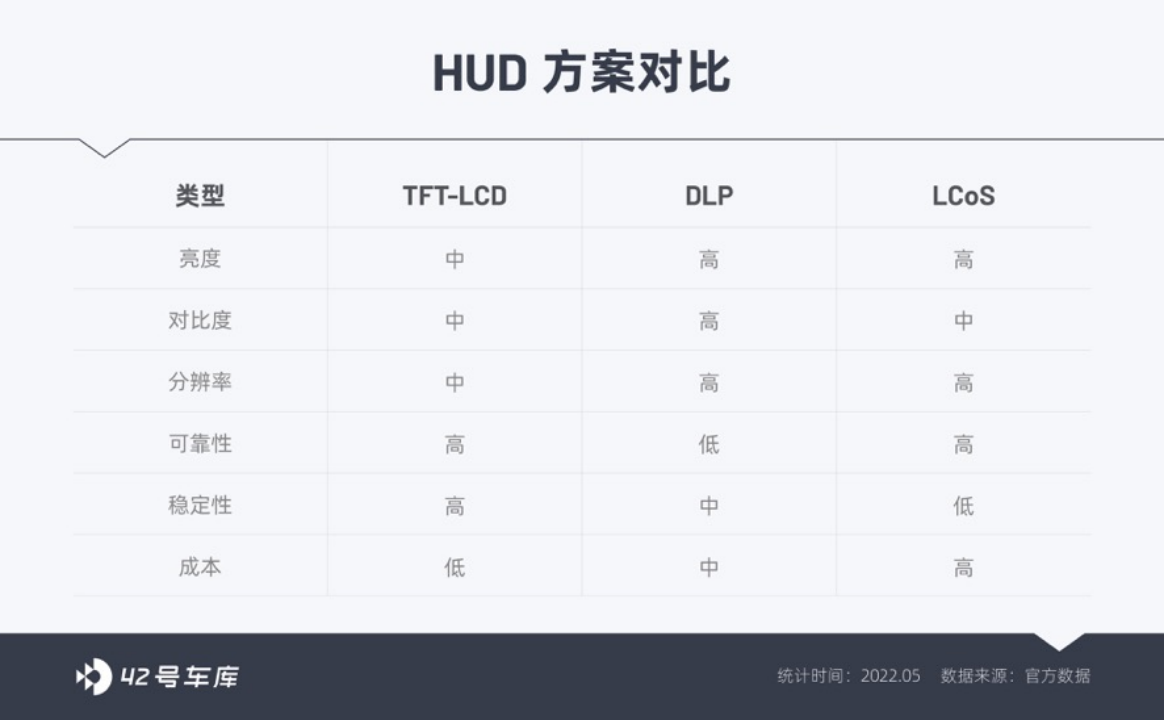
Compared to the penetrating projection used by LCD, LCoS utilizes reflective projection, which has the advantage of higher light efficiency, up to 40\% in the highest case, while traditional LCD penetrating projection is only 3\%. This increase in light efficiency provides the AR-HUD of the Fyber R7 with higher brightness and resolution.
Algorithm Determines the Final Effect
After having powerful projection hardware, the next challenge is to test the tuning ability of Huawei. Compared to a traditional HUD, AR-HUD adds augmented reality effects, which is merging the generated image with the real environment. When our viewpoint changes, the image must always appear in the correct position accurately, otherwise, the image and the environment may be misaligned, rendering the AR-HUD meaningless.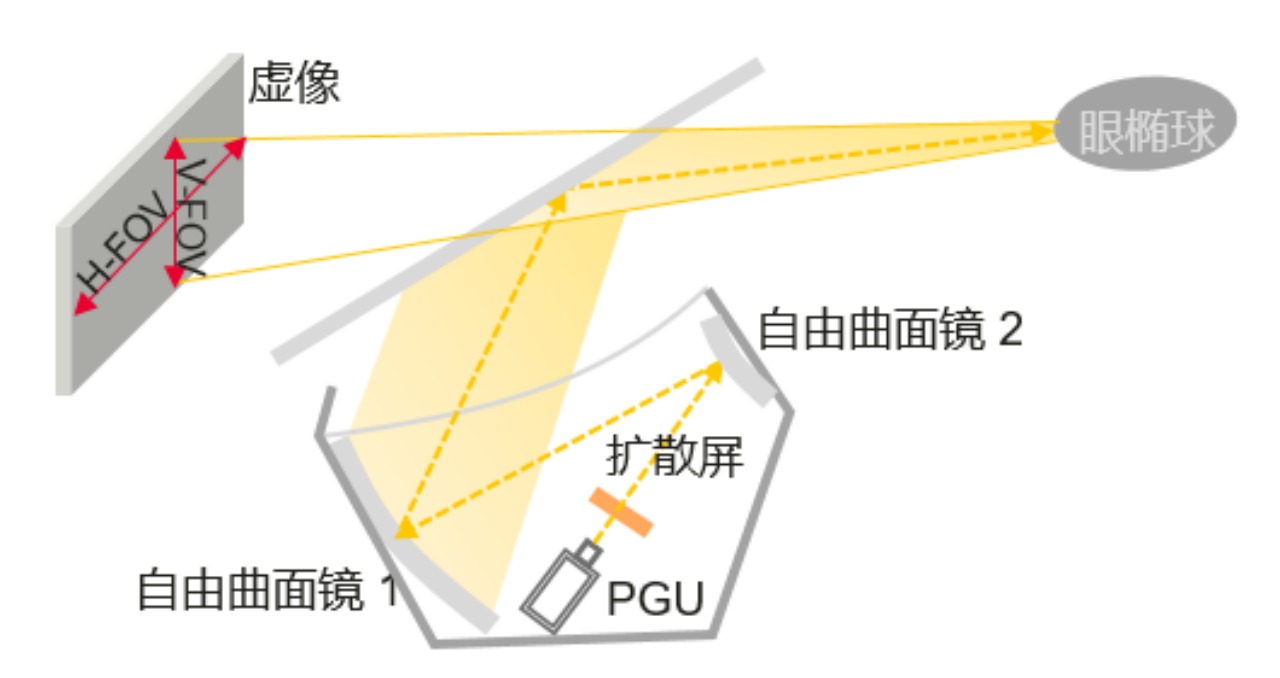
Huawei uses a state monitoring system based on IMU (Inertial Measurement Unit) and DMS (Driver Monitoring System) to provide real-time feedback and keep the screen stable. Additionally, it uses various information such as navigation signals, real-time location signals, real-time road condition signals, real-time speed, and direction, to connect the cabin space with the world space in real-time.
Considering the display delay and display errors of AR and various other issues, the final stability and display effect of the system depend on the actual performance of mass-produced vehicles once they are on the market.
Currently, there is not much information available about this system on the market, but it has Huawei’s strong endorsement in the field of optoelectronic communication, so there is no need to worry too much. With such a powerful “weapon,” can the Flyaway R7 make a “delicious dish” with it? This is my biggest concern right now, after all, the biggest problem with HUD at this stage is not performance, but the lack of features.
A Feast Fit for Emperors
If the global debut of the Huawei Vision Enhancement AR-HUD level-up “weapon” only whetted my appetite, then the “culinary skills” of Flyaway R7 this time is like serving me up a “feast fit for emperors”.
Why do I say it is a “feast fit for emperors”? Because Flyaway R7 has almost covered all the application scenarios of HUD that you can see on the market right now. In addition to the most basic:
- Navigation information assistance: lane information, TBT guidance, remaining distance, estimated time of arrival, and road name, etc.
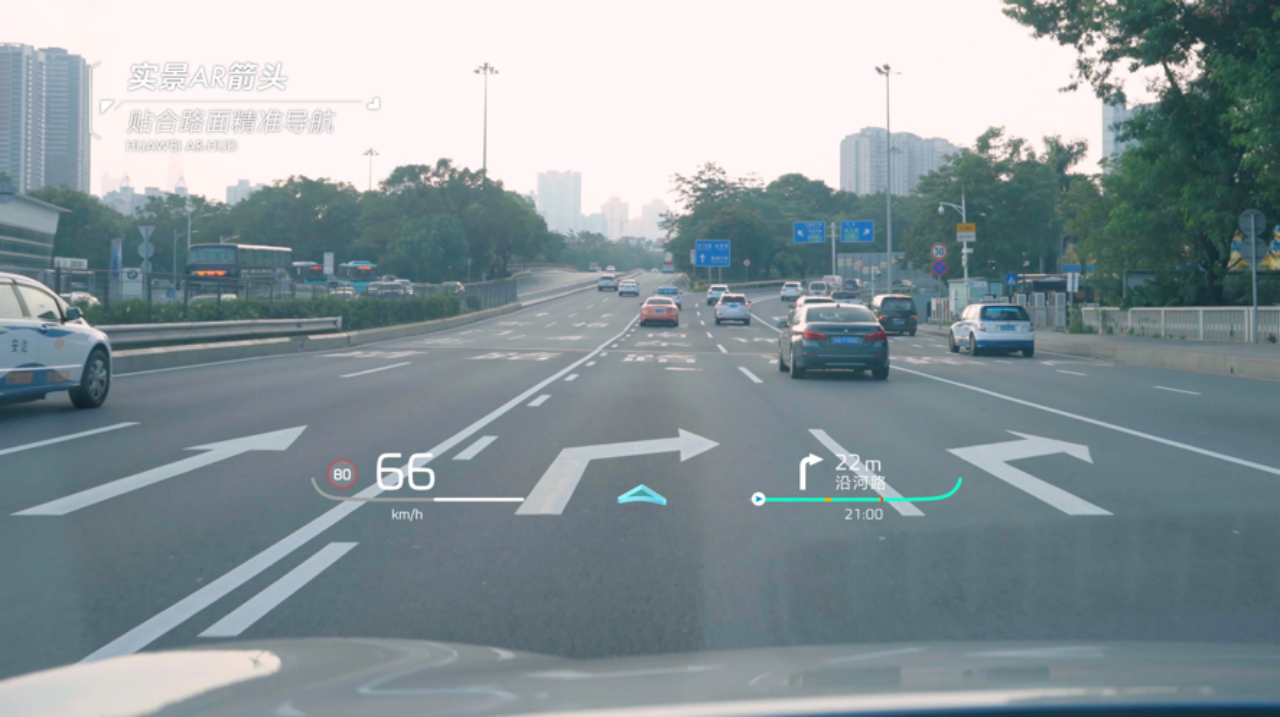
Compared with traditional HUD, there is already an experiential gap in basic navigation information assistance. The larger display area and farther VID bring more information.
In the demo video presented by Flyaway R7, speed-related information is placed on the left side, and navigation-related information is displayed on the right side. Key intersection prompts, time, and remaining distance are already enough to let us almost do not need to look at the navigation screen on the display.
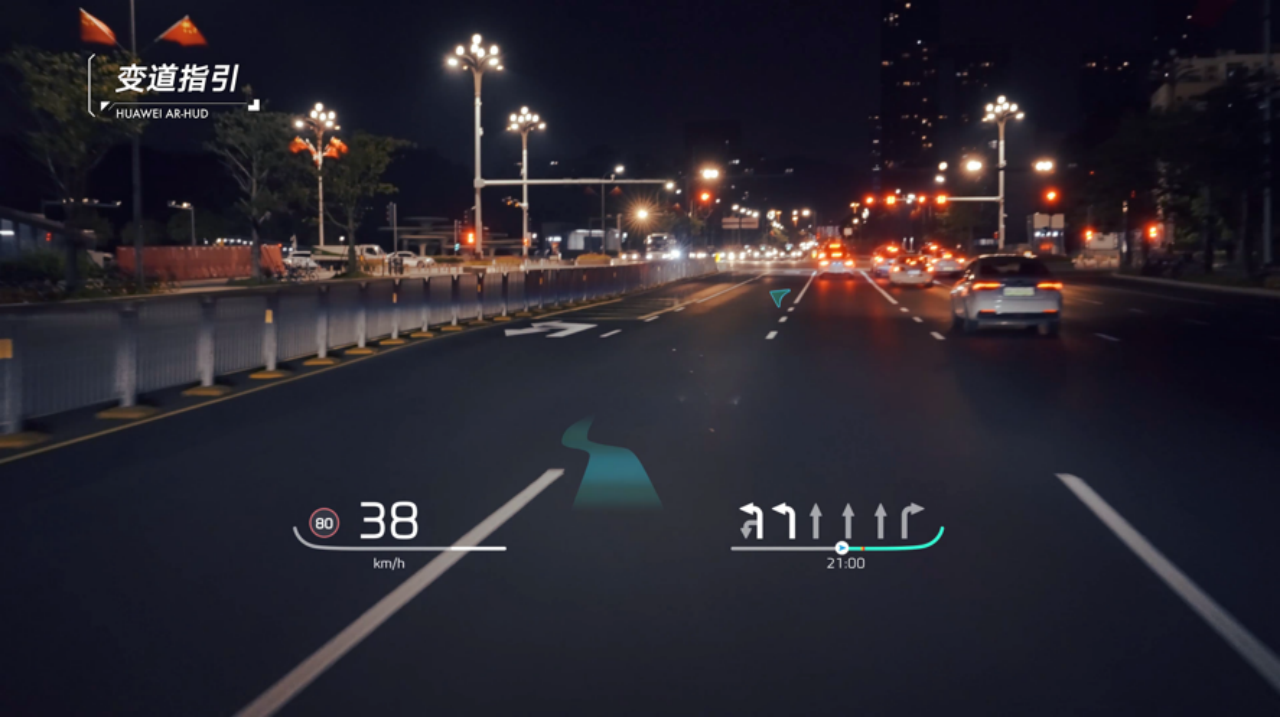
- AR navigation guidance: AR navigation, real-scene destination, etc.
If reading is not intuitive enough, the middle part of the AR navigation arrow simply and directly points out the direction of the next intersection for the driver in the least error-prone way, which is something traditional HUD cannot achieve.
 Believe it or not, we may need to slow down and carefully compare the differences between the actual road scenes and the map at complex junctions to avoid making a wrong turn. Nowadays, making a wrong turn on the elevated road can lead to driving an extra ten kilometers if you’re not lucky enough. With AR navigation, based on map data and precise GPS positioning, the directional arrow will be directly superimposed on the correct intersection in the form of AR, greatly reducing the chance of making mistakes.
Believe it or not, we may need to slow down and carefully compare the differences between the actual road scenes and the map at complex junctions to avoid making a wrong turn. Nowadays, making a wrong turn on the elevated road can lead to driving an extra ten kilometers if you’re not lucky enough. With AR navigation, based on map data and precise GPS positioning, the directional arrow will be directly superimposed on the correct intersection in the form of AR, greatly reducing the chance of making mistakes.
It also includes safety-assist features:
- Lane departure warning, lane changing guidance, target recognition for following cars, tailing distance, obstacle collision warning, etc.
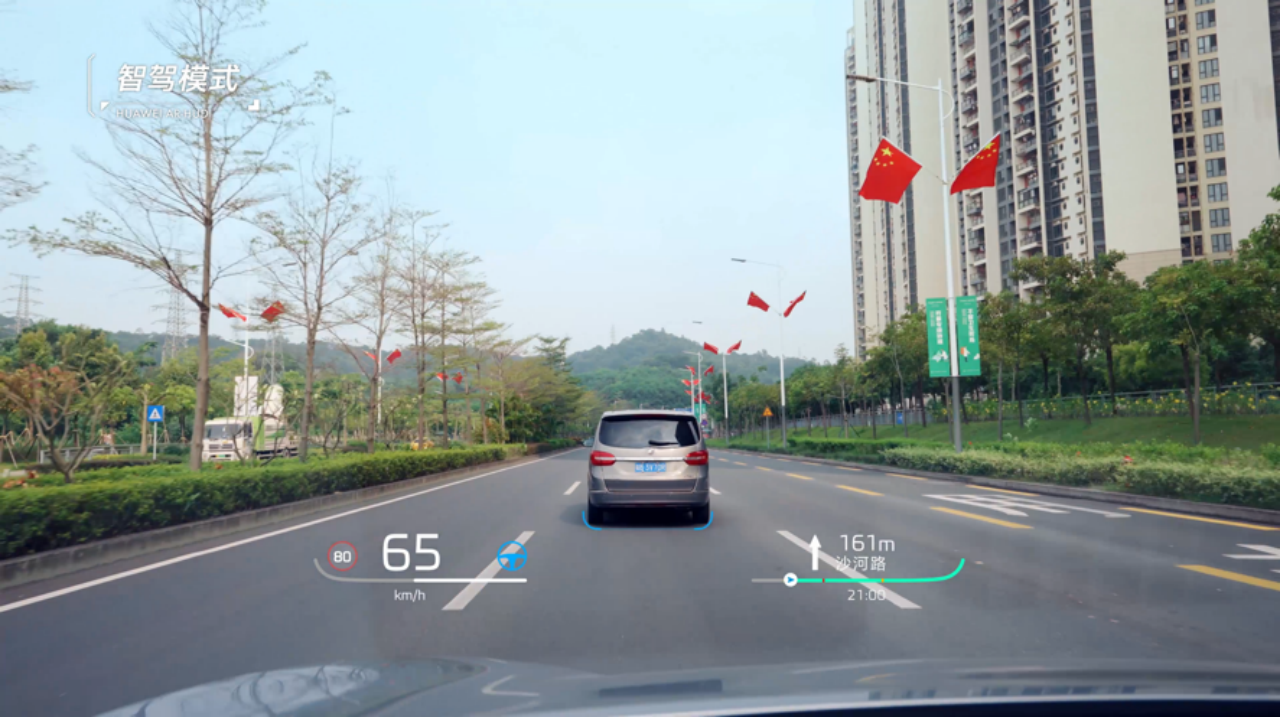
The target recognition for following cars is a function that automatically recognizes the front vehicle and creates a selected frame below the vehicle. When following too closely, an alarm will appear. Although this function is often overlooked, it is the most reassuring safety feature.
As we all know, the probability of vehicle recognition by the current ADAS system is not 100%. Therefore, before a collision occurs, you are not sure whether the vehicle has recognized the front vehicle or not. That’s why almost all models visualize the ADAS information on the instrument screen, just to tell you clearly, “Don’t worry, I see the vehicle ahead.” However, we can’t keep looking at the instrument while driving. The “box” on the AR-HUD solves this problem very well.
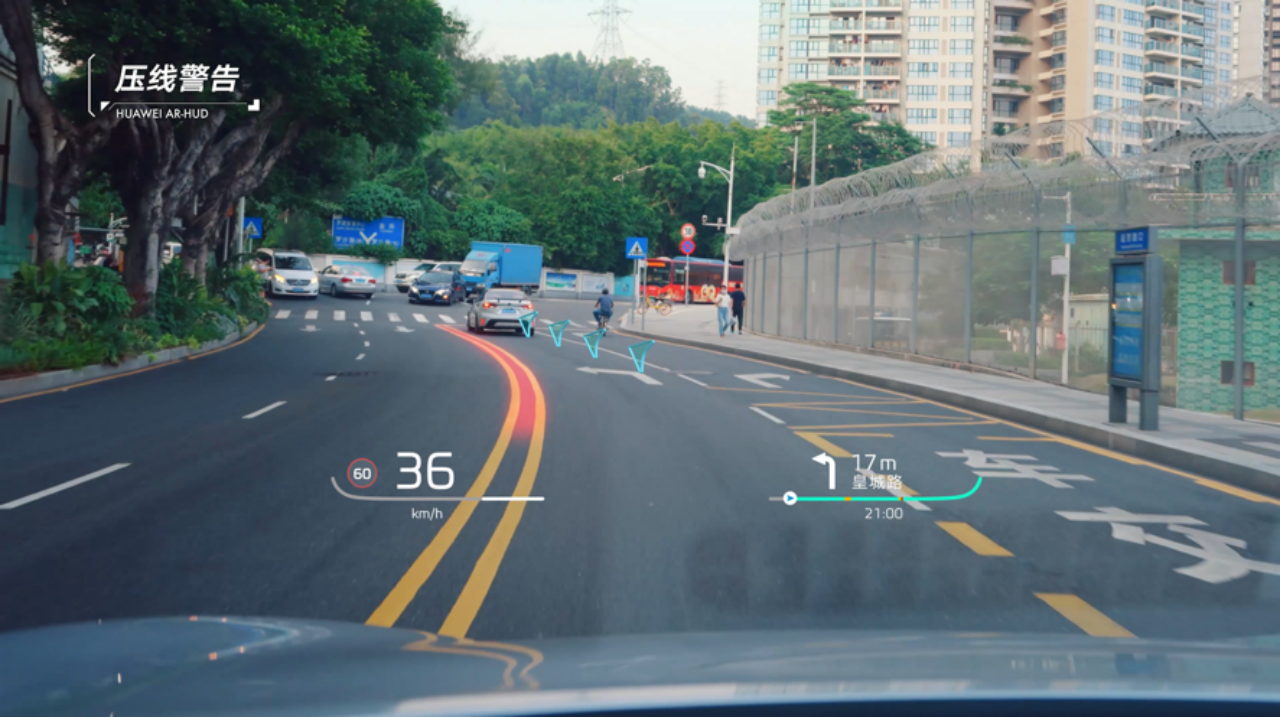
The system even combines map merchant data and projects it onto the AR-HUD when you need it most:
- Life service application: By superimposing map POI information on the reality, and real-time labeling of consumption, vehicle service-related locations such as parking lots, restaurants, shopping places, etc., it provides practical applications.
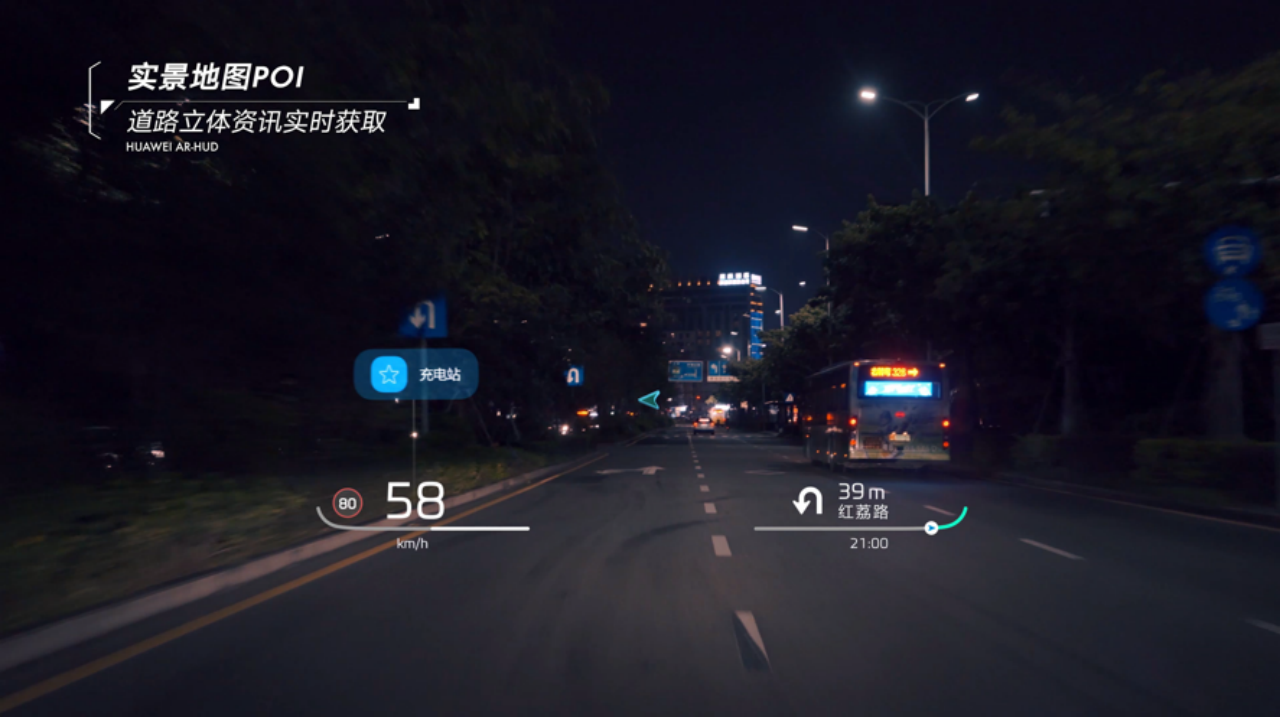
This feature is very practical when driving in unfamiliar areas. After all, who doesn’t prefer “real-person guidance” over 2D map guidance? The AR arrow guidance combined with map POI data is like having a local standing in front of your car, waving his hand and saying, “Hey, the charging station is over here. Don’t make a wrong turn.”
Of course, the RisingAuto R7 AR-HUD also includes entertainment functions:
- When parked, the AR-HUD can be used to experience audio and video entertainment.
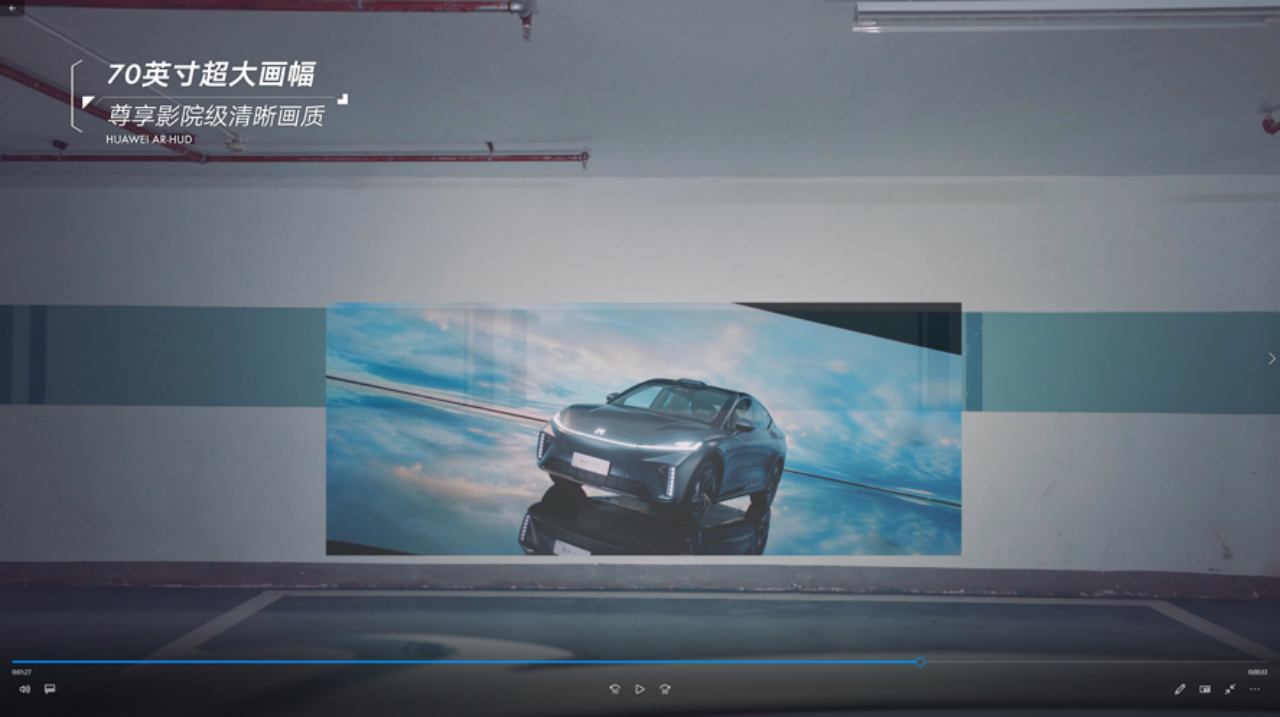 The HUD that can be used for watching movies is something I have heard for the first time. However, with a resolution of 1,920 × 730, it has exceeded the level of HD 720P and can be considered a leader in HUD, even surpassing some models of LCD instrumentation.
The HUD that can be used for watching movies is something I have heard for the first time. However, with a resolution of 1,920 × 730, it has exceeded the level of HD 720P and can be considered a leader in HUD, even surpassing some models of LCD instrumentation.
But what level of performance can be achieved when playing movies is still an unknown. This is the aspect that I am most looking forward to experiencing. Although watching movies on HUD may be considered a fake demand, it is more than enough to satisfy the basic needs of HUD by using a HUD that can be used for watching movies.
I even have the feeling that with just one HUD, FEIFAN R7 is able to combine the functions of LCD instrumentation and HUD. The only feature that I can think of that it may not have is to display trouble codes.
Conclusion
With the exposure of the AR-HUD parameters, the entire cabin of FEIFAN R7 has been presented in front of us. While marveling at the powerful performance of this HUD, what surprises me more is “FEIFAN”.
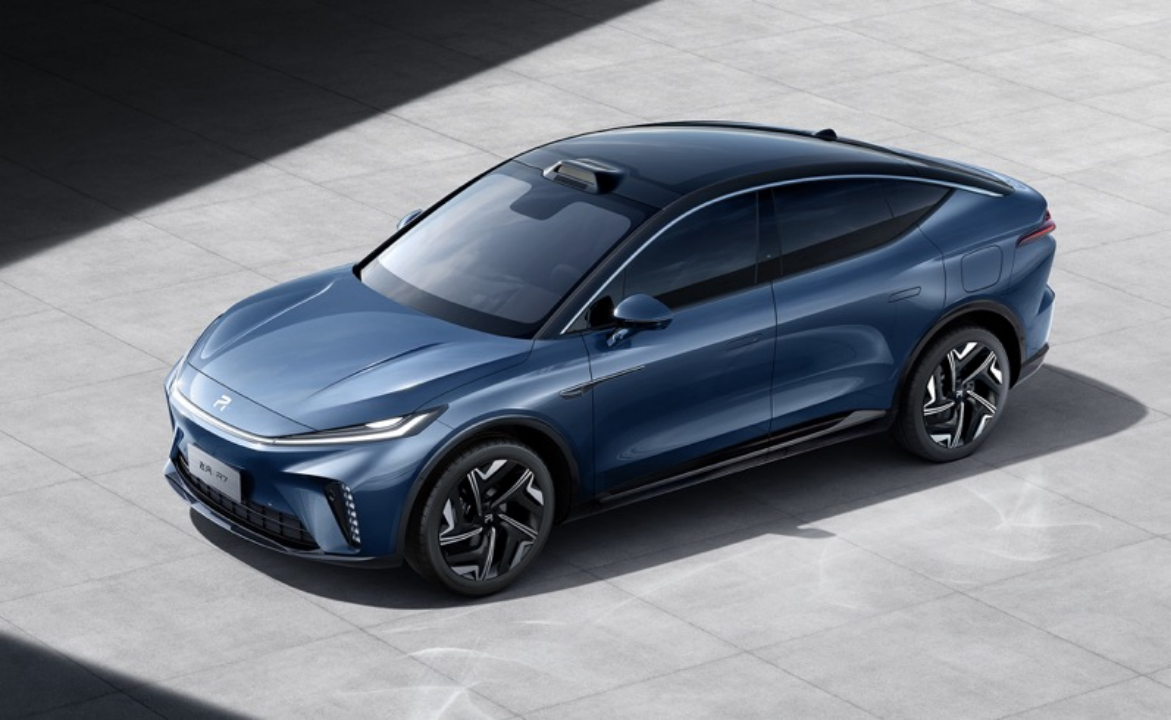
Although intelligence has become a trend that has been talked about repeatedly in the industry, we also pay special attention to the sections of intelligent driving and intelligent cabins at each new car release conference. However, the real stunning parts are concentrated in only a few new force brands.
Most new energy brands originating from domestic auto manufacturers tend to focus more on three-electricity parameters—their strengths—while neglecting the experience of intelligent cabins. Even if they launch intelligent configuration due to market pressure, it is still a product mentality, completely ignoring the actual use experience. It is not so much that they don’t want to do well, but rather that they lack the ability.
In terms of FEIFAN’s intelligent cabin, whether it is chip performance or screen quality, HUD effect or comfort configuration, there are not many flaws that can be found. It can even be said that it has achieved the extreme. Before experiencing the delivery, it is difficult for us to affirm that the cabin experience of FEIFAN R7 is good. What we can see is that FEIFAN has achieved leadership in several key indicators that we focus on in the cabin.
However, hardware determines the upper limit of its capabilities, while software determines the lower limit of experience. Since the hardware has reached its limit, the pressure is now on the software department. From hardware, we can see SAIC’s determination to enter a new era. We also hope to see a real turnaround of domestic brands from hardware and the gradual blurring of the boundaries between traditional automakers and new force brands.
This article is a translation by ChatGPT of a Chinese report from 42HOW. If you have any questions about it, please email bd@42how.com.
